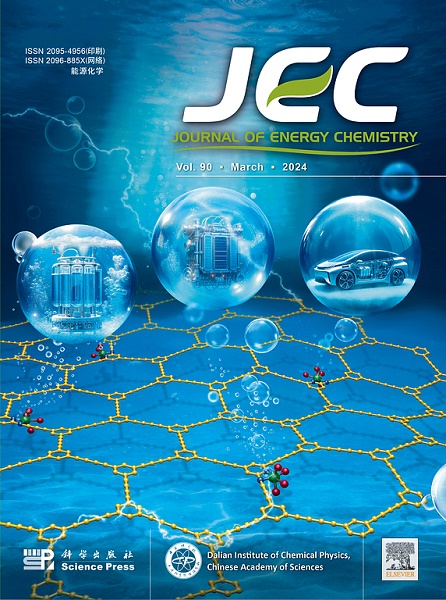Sufficient cathode infiltration for stable 500 Wh kg−1 level lithium–sulfur batteries
IF 13.1
1区 化学
Q1 Energy
引用次数: 0
Abstract
Lithium–sulfur (Li–S) batteries are promising next-generation high-energy-density energy storage devices. However, the failure mechanism of 500 Wh kg−1 level Li–S pouch cells has not been well understood. Herein, quantitative and systematic failure analysis is conducted on 500 Wh kg−1 level Li–S pouch cells to understand the underlying failure mechanism. Focusing on electrolyte exhaustion as the primary cause of cell failure, quantitative analysis methods are established to determine electrolyte occupation by physical infiltration of the cathode, separator, and anode as well as chemical consumption by lithium metal. Insufficient physical infiltration of the cathode caused by irreversible cathode volume expansion is identified as the main cause of electrolyte exhaustion. In comparison, chemical consumption of electrolytes by lithium metal and insufficient anode infiltration have limited influence on cell operations. To address the insufficient cathode infiltration, macropore-rich sulfur cathodes are fabricated to suppress the irreversible volume expansion and prolong the cycling lifespan of Li–S pouch cells by 2.4 times. This work elucidates that the sulfur cathode dominates the cycling lifespan of high-energy-density Li–S batteries and highlights cathode structural design to mitigate irreversible volume expansion for cycling performance improvement.

为稳定的500wh kg−1级锂硫电池提供充足的阴极渗透
锂硫(li -硫)电池是下一代高能量密度储能设备。然而,500wh kg−1级锂- s袋电池的失效机制尚未得到很好的理解。本文对500 Wh kg−1级锂- s袋状电池进行了定量和系统的失效分析,以了解潜在的失效机制。针对电解液耗竭是电池失效的主要原因,建立了定量分析方法,通过阴极、分离器和阳极的物理渗透来确定电解液的占用以及锂金属的化学消耗。不可逆的阴极体积膨胀引起的阴极物理浸润不足被认为是电解液耗竭的主要原因。相比之下,锂金属对电解液的化学消耗和阳极渗透不足对电池运行的影响有限。为了解决阴极渗透不足的问题,制备了富大孔硫阴极,抑制了不可逆的体积膨胀,将Li-S袋状电池的循环寿命延长了2.4倍。这项工作阐明了硫阴极在高能量密度Li-S电池的循环寿命中占主导地位,并强调了阴极的结构设计,以减轻不可逆的体积膨胀,从而提高循环性能。
本文章由计算机程序翻译,如有差异,请以英文原文为准。
求助全文
约1分钟内获得全文
求助全文
来源期刊

Journal of Energy Chemistry
CHEMISTRY, APPLIED-CHEMISTRY, PHYSICAL
CiteScore
19.10
自引率
8.40%
发文量
3631
审稿时长
15 days
期刊介绍:
The Journal of Energy Chemistry, the official publication of Science Press and the Dalian Institute of Chemical Physics, Chinese Academy of Sciences, serves as a platform for reporting creative research and innovative applications in energy chemistry. It mainly reports on creative researches and innovative applications of chemical conversions of fossil energy, carbon dioxide, electrochemical energy and hydrogen energy, as well as the conversions of biomass and solar energy related with chemical issues to promote academic exchanges in the field of energy chemistry and to accelerate the exploration, research and development of energy science and technologies.
This journal focuses on original research papers covering various topics within energy chemistry worldwide, including:
Optimized utilization of fossil energy
Hydrogen energy
Conversion and storage of electrochemical energy
Capture, storage, and chemical conversion of carbon dioxide
Materials and nanotechnologies for energy conversion and storage
Chemistry in biomass conversion
Chemistry in the utilization of solar energy
 求助内容:
求助内容: 应助结果提醒方式:
应助结果提醒方式:


